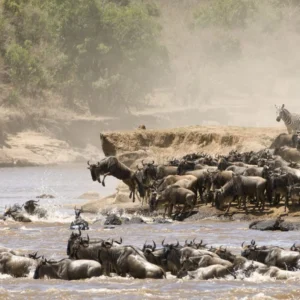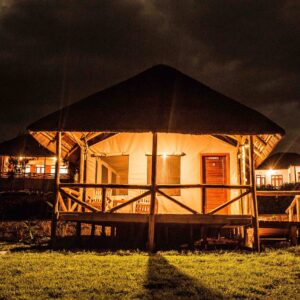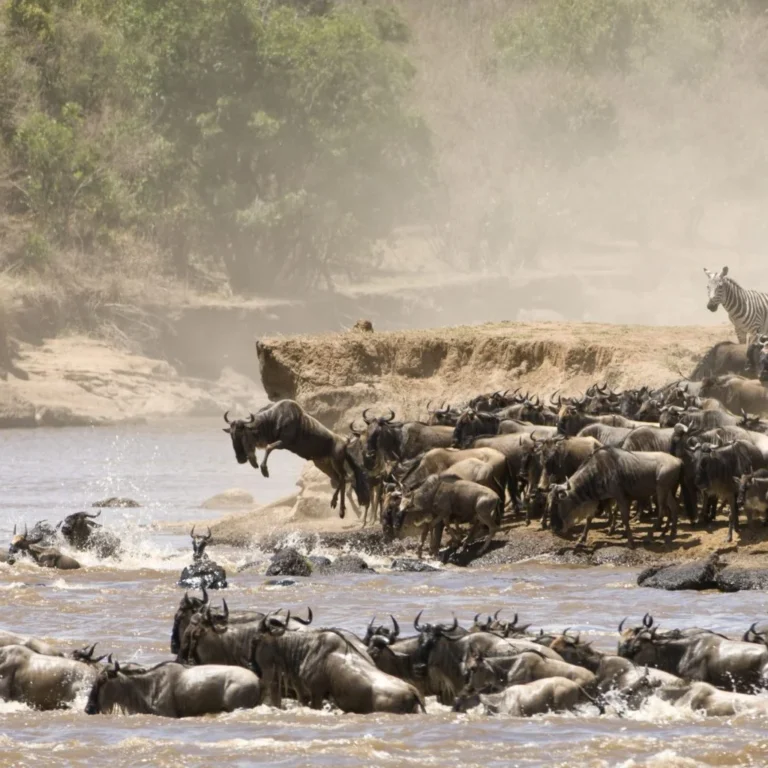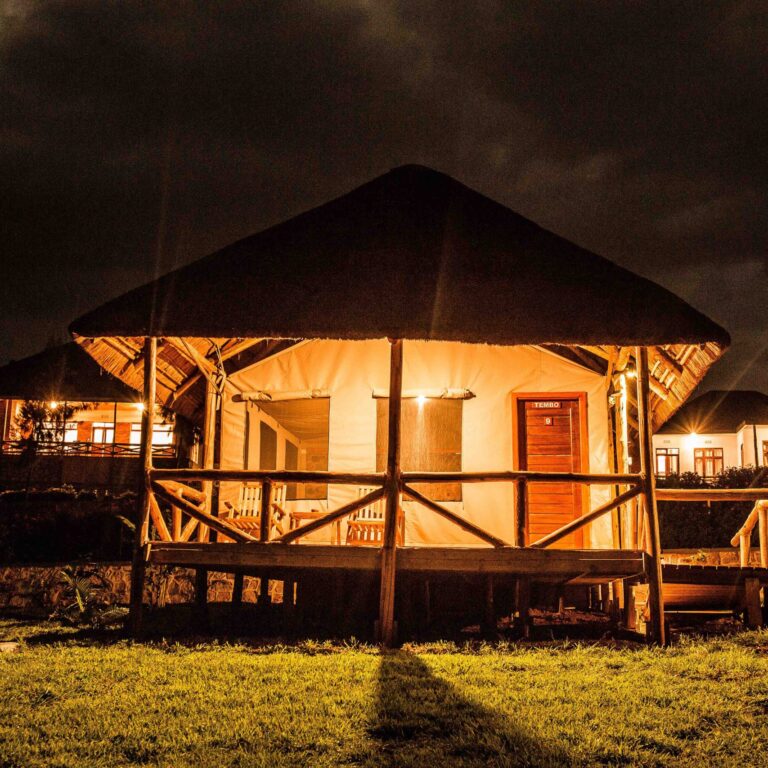The Ngorongoro Crater is renowned for its incredible wildlife viewing opportunities, including the “Big Five” (lion, elephant, buffalo, leopard, and rhinoceros) and many other fascinating species. Some of the most amazing animals to spot include black rhinos, lions, elephants, buffalo, zebras, wildebeest, cheetahs, hippos, hyenas, and the rare wild dogs. The Ngorongoro Crater, often hailed as the “Eighth Wonder of the World,” is a geological marvel and a UNESCO World Heritage Site in northern Tanzania. This immense, unbroken volcanic caldera acts as a natural enclosure. Creating a self-contained ecosystem where wildlife thrives in astonishing density. Descending into this verdant bowl is like entering a lost world. A vibrant arena where Africa’s most iconic animals coexist in remarkable harmony.
For safari enthusiasts, the Ngorongoro Crater offers an unparalleled wildlife viewing experience. Often guaranteeing sightings that might take days to achieve elsewhere. Here are 12 of the most amazing animals you’re almost certain to spot within this unique natural sanctuary. Each contributing to the crater’s legendary status.
1. Black Rhinos (Diceros bicornis): The Critically Endangered Jewel
Perhaps the most sought-after sighting in the Ngorongoro Crater is the critically endangered Black Rhino. The crater is one of the few places in Tanzania where you have a realistic and relatively high chance of spotting these magnificent, prehistoric-looking browsers. Thanks to intensive anti-poaching efforts and the natural protection offered by the crater walls. The Ngorongoro boasts a small but stable population. Witnessing a black rhino grazing peacefully is a powerful and humbling reminder of vital conservation successes.
2. Lions (Panthera leo): The Crater’s Apex Predators
The Ngorongoro Crater is home to a healthy and easily observable population of Lions. These majestic big cats are the apex predators of the crater floor. Often seen in prides, lounging under acacia trees, or stalking prey across the open grasslands. Their presence is a constant reminder of the raw power of the wild. The relatively contained environment of the crater means that lion sightings are frequent, and you might even witness them on a hunt.
3. Elephants (Loxodonta africana): The Crater’s Gentle Giants
While the Ngorongoro Crater is famous for its large herds of plains game, the Elephants here are particularly noteworthy. Unlike the large breeding herds found in other parks, the crater’s elephant population primarily consists of magnificent bull elephants. These older, often solitary, males prefer the rich vegetation and permanent water sources within the crater. Spotting these gentle giants against the crater walls is a truly iconic image.
4. African Buffalo (Syncerus caffer): The Formidable Grazer
The African Buffalo is a ubiquitous sight on the crater floor, forming large herds that graze the lush grasslands. These powerful and formidable animals are an essential part of the crater’s ecosystem, providing a significant food source for its dense predator populations. Their sheer numbers and imposing presence make them a constant feature of any Ngorongoro safari.
5. Zebras (Equus quagga): Striped Beauties of the Plains
The striking black and white stripes of the Plains Zebra are a common and beautiful sight across the Ngorongoro Crater floor. Often seen in large herds, sometimes mixed with wildebeest, their unique patterns are believed to help confuse predators and deter insects. Their constant grazing contributes to maintaining the open grasslands, which in turn support other herbivores and their predators.
6. Wildebeest (Connochaetes taurinus): The Resident Herds
While the Great Migration of wildebeest is famous in the Serengeti, the Ngorongoro Crater also hosts its significant resident population of Wildebeest. These herds do not participate in the long-distance migration but remain within the crater, enjoying its year-round grazing and water. Their presence provides a continuous food source for the crater’s numerous predators. Making sightings of hunts relatively common.
7. Cheetahs (Acinonyx jubatus): The Speed Demons
The open grasslands of the Ngorongoro Crater provide an ideal hunting ground for the sleek and speedy Cheetahs. While more elusive than lions, the crater’s excellent visibility and high prey density offer good opportunities to spot these magnificent cats. Witnessing a cheetah stalking its prey, or even engaging in its explosive pursuit, is an exhilarating and unforgettable highlight of a crater safari.
8. Hippos (Hippopotamus amphibius): The Waterhole Wonders
The permanent water sources within the Ngorongoro Crater, particularly the Ngoitokitok Springs and other pools, are home to large pods of Hippos. These semi-aquatic giants spend their days submerged to protect their sensitive skin from the sun, emerging at night to graze. Their noisy grunts, snorts, and yawns are a constant soundtrack around the waterholes. And observing their social dynamics in the water is fascinating.
9. Hyenas (Crocuta crocuta): The Misunderstood Scavengers
The Spotted Hyena thrives in the Ngorongoro Crater, playing a crucial role as both scavenger and formidable hunter. Often seen in large clans, their distinctive “laughing” calls echo across the plains. Their powerful jaws and highly social structure make them incredibly efficient at cleaning up carcasses. But they are also capable of taking down large prey, often competing directly with lions.
10. Wild Dogs (Lycaon pictus): A Rare and Precious Sight
While not as common as in some other parks, the African Wild Dog (also known as Painted Dog) is occasionally sighted in the Ngorongoro Conservation Area. Though very rarely on the crater floor itself. These highly endangered and intelligent pack hunters are a thrilling and precious sighting for any safari-goer. Their presence, even if rare, underscores the ecological richness of the broader conservation area.
11. Flamingos (Phoeniconaias minor / Phoenicopterus roseus): Pink Hues on the Lake
Lake Magadi, a soda lake on the crater floor, often hosts thousands of Flamingos. Creating a stunning spectacle of pink against the blue waters and green plains. Both Lesser and Greater Flamingos most amazing Ngorongoro Crater Animals to Spot, can be found here, feeding on the algae. Their graceful movements and vibrant colors provide a beautiful contrast to the larger mammals. Offering excellent photographic opportunities.
12. Elands (Taurotragus oryx): Africa’s Largest Antelope
The majestic Eland is Africa’s largest antelope, and these impressive animals are commonly sighted within the Ngorongoro Crater, the most amazing Ngorongoro Crater Animals to Spot. Both sexes have spiral horns, and males develop a distinctive dewlap. Their massive size and powerful build make them a formidable presence on the plains, and observing them alongside smaller grazers highlights the diversity of the crater’s herbivore population.
Why is there no giraffe in the Ngorongoro Crater? There are a large number of wild creatures in the area. The Ngorongoro crater is home to nearly all of Tanzania’s diverse animal species, although there are no giraffes. They are unable to enter because the walls are too steep for them to walk down.
What animal is not found in the Ngorongoro Crater? Elephants, eland, and hartebeest also live in the crater, while hippos can be seen in the permanent freshwater pools and swamps. Interestingly, giraffes are absent due to the crater’s steep walls, which make access difficult.
Why is there no impala in the Ngorongoro Crater? No Giraffe & Impala Live in the Ngorongoro Crater. The only unexpected absentees from the 25,000+ mammals that live inside the Crater are giraffes and impala. The lack of open woodlands and certain tree species favored by these animals is believed to be the reason for their dearth.
What is the size of the Ngorongoro Crater? The Ngorongoro Crater is a massive, intact volcanic caldera with a surface area of approximately 260 square kilometers (100 square miles). It’s roughly 20 kilometers (12 miles) in diameter, and the crater walls are about 610 meters (2,000 feet) high,
Here’s a more detailed breakdown:
- Surface area. 260 square kilometers (100 square miles).
- Diameter. Approximately 20 kilometers (12 miles).
- Depth. Ranges from 600 to 700 meters (1,970 to 2,300 feet) on average, with some areas exceeding 800 meters (2,600 feet) from the rim to the crater floor.
- Elevation. The crater rim is around 2,400 meters (7,900 feet) above sea level.
Conclusion: A Microcosm of African Majesty
The Ngorongoro Crater is truly a microcosm of African majesty, a place where an astonishing array of wildlife coexists within a dramatic and breathtaking natural amphitheater. From the rare Black Rhino to the iconic Lion, the graceful Flamingo to the powerful Eland, every sighting contributes to an unforgettable safari experience. Descending into this “Lost World” offers a unique opportunity to witness nature’s grandeur up close, leaving you with a profound appreciation for the wild heart of Tanzania.






